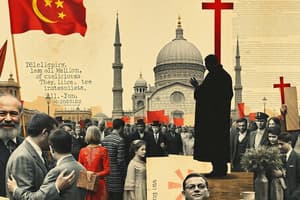Podcast
Questions and Answers
What is highlighted as the oldest source of human identity and conflict?
What is highlighted as the oldest source of human identity and conflict?
- Religion (correct)
- National identity
- Gender identity
- Class identity
Which conflict is NOT mentioned as an example of religious divides in the text?
Which conflict is NOT mentioned as an example of religious divides in the text?
- 1990s war in Yugoslavia
- Apartheid in South Africa (correct)
- Sunni and Shia conflict in Iraq
- Crusades
In the 18th century, what identity was highlighted as superseding religious identity in many parts of the world?
In the 18th century, what identity was highlighted as superseding religious identity in many parts of the world?
- Gender identity
- Class identity
- National identity (correct)
- Religious identity
Which theorist focused on identities based on the relationship to the means of production?
Which theorist focused on identities based on the relationship to the means of production?
What is highlighted as a determining factor of class according to Weber?
What is highlighted as a determining factor of class according to Weber?
In the 19th century, what stages did Taylor propose for human development?
In the 19th century, what stages did Taylor propose for human development?
What did genetic studies in the 20th century find regarding race?
What did genetic studies in the 20th century find regarding race?
What did the 'racial sciences' of the 19th century believe about races?
What did the 'racial sciences' of the 19th century believe about races?
What idea did Huntington present regarding civilizations in the 20th century?
What idea did Huntington present regarding civilizations in the 20th century?
Which factors were listed as components of one's identity in the text?
Which factors were listed as components of one's identity in the text?
How does a Confucian perspective define communication?
How does a Confucian perspective define communication?
In Berlo's model of communication, how is the source viewed?
In Berlo's model of communication, how is the source viewed?
How is encoding (speaking) viewed in Berlo's model compared to decoding (listening)?
How is encoding (speaking) viewed in Berlo's model compared to decoding (listening)?
What is the primary function of media in intercultural communication according to the text?
What is the primary function of media in intercultural communication according to the text?
In the context of intercultural communication, what role does design elements play in media?
In the context of intercultural communication, what role does design elements play in media?
What term refers to a group of people of the same descent and heritage who share a common and distinctive culture passed on through generations?
What term refers to a group of people of the same descent and heritage who share a common and distinctive culture passed on through generations?
In the context of culture, what do symbols represent?
In the context of culture, what do symbols represent?
Which term refers to real or imaginary people who serve as behavior models within a culture?
Which term refers to real or imaginary people who serve as behavior models within a culture?
What is a distinguishing characteristic of ethnicity among people of the same descent and heritage?
What is a distinguishing characteristic of ethnicity among people of the same descent and heritage?
Which term describes a subdivision based on geographic region, ethnicity, or economic or social class within a dominant culture?
Which term describes a subdivision based on geographic region, ethnicity, or economic or social class within a dominant culture?
Flashcards are hidden until you start studying
Study Notes
- In the 19th century, racial sciences categorized races from primitive to most advanced, ordered by power-holding Europeans.
- In the 20th century, genetic studies found no single gene defining race; popular indicators of race include religion, nationality, civilization, and ethnicity.
- Taylor's developmental stages (savagery, barbarism, and civilization) in the 19th century perpetuated the idea that Western nations are superior.
- Huntington's civilizations in the 20th century categorized societies based on cultural and political differences.
- Identity can be defined by religion, nationality, class, and race.
- Culture is a community with a population large enough to produce new generations, consisting of symbols, rituals, values, and heroes.
- Subcultures exist within dominant cultures and often based on geographic region, ethnicity, or economic or social class.
- Ethnicity refers to a group of people of the same descent and heritage who share a common and distinctive culture.
- Religion is the oldest source of human identity and conflict, providing a sense of identity for groups and sometimes resulting in conflict.
- National identity emerged in the 18th century as a primary identity in many parts of the world and can lead to conflict.
- Class identity is based on the relationship to the means of production or determined by skill and education, leading to different social classes.
- Communication is the code we learn and share, requiring both learning and sharing, and can be influenced by cultural perspectives.
- The media of intercultural communication can increase contact and understanding between cultures through various methods like human couriers, telephone, text messaging, internet, social media, and language design.
Studying That Suits You
Use AI to generate personalized quizzes and flashcards to suit your learning preferences.




